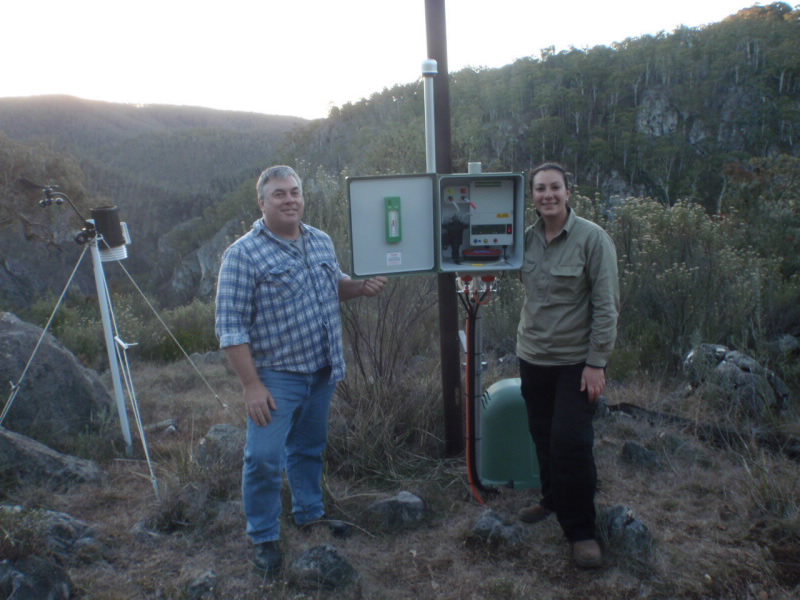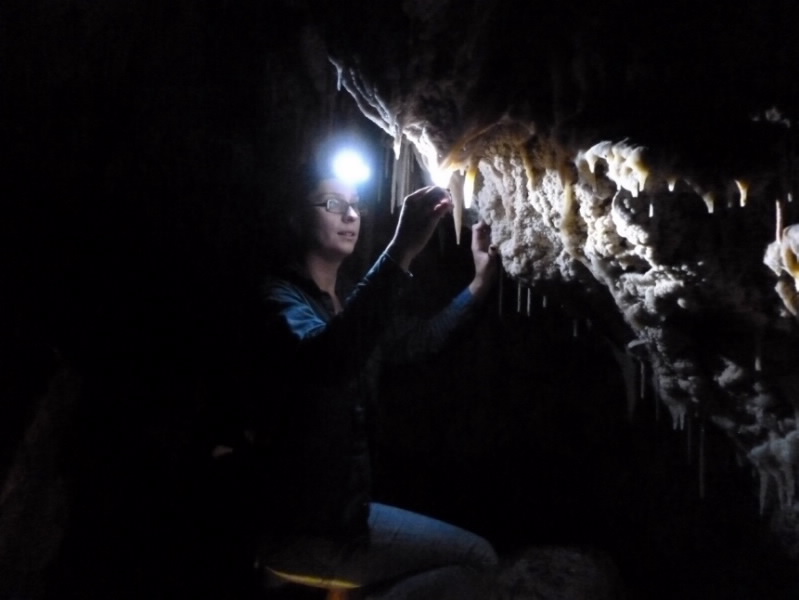 |
| Carol Tadros (left), Regina Roach (centre) and Monika Markowska (right) in Harrie Wood Cave, Yarrangobilly. |
Climate variability as we know it today is due to both human activities as well as natural processes which have been occurring over millions of years.
Calcium carbonate formations (eg. stalagmites) found in caves can be used to provide very good insights into the climate of the past yielding records since the time of their creation.
Scientists from ANSTO studying cave formations (speleothems) have set out to produce high resolution records of past climate for the Snowy Mountains western slopes region in Australia over the last 2000 years.
The paleo-environmental record offers a unique opportunity to find evidence of how climate has changed in the past for a given area.
Relatively few records of this nature have been developed for southeast Australia, particularly those focused on the recent past (last 1000-2000 years) for which climatic conditions are most similar to our present day.
As part of their PhDs, ANSTO paleo-environmental scientists Carol Tadros and Monika Markowska are working on projects aimed at monitoring the karst-climate interactions in Harrie Wood Cave located in the Yarrangobilly Caves area in the north of Kosciuszko National Park, New South Wales, Australia.
One of the hypotheses they’re currently investigating is that trace elements from dust storms, such as the 2009 Australian dust storm, may be detectable in the drip water. This type of discovery would in effect help calibrate their investigative techniques as they move further back through climate records of the cave.
It is becoming increasingly recognised that an important process in speleothem studies involves monitoring the cave environment. Yarrangobilly Caves in the Snowy Mountains provides an opportunity to examine past hydrologic variability in the speleothem scientific record.
Monitoring at Yarrangobilly Caves began in 2006 in Harrie Wood Cave with the assistance of NSW Department of Environment and Heritage staff and is one of the longest running cave monitoring programs worldwide. It is also the only monitored alpine karst environment in Australia and otherwise, the only one of three such programs in Australia the other two being located at Wombeyan Caves and SW Western Australia.
 |
| David Garton (left) and Carol Tadros (right) installing an aerosol sampler at Yarranogbilly. |
Carol’s research project is investigating the use of trace elements in speleothems as paleo-environmental archives. Speleothem geochemical records are becoming increasingly important in defining our future understanding of past climates. It’s not the first time this type of study has been conducted with previous investigations utilising the distribution of trace elements throughout stalagmites as a successful proxy to reconstruct past climates.
To help build on this method though and gain a more holistic understanding of the modern atmosphere-soil-karst-stalagmite interaction, Carol expanded her cave monitoring program to include aerosol sampling, soil and bedrock leaching experiments and trace element chemistry of the drip water and stalagmites.
It’s the first study of its kind to obtain a high resolution multiple element variation record in stalagmites at Yarrangobilly Caves. The aim will be to use this geochemical record to help interpret past records, which can only be done by calibrating it against an age dated stalagmite as the growth extends to the 20th century to develop a direct link between past and present.
 |
| Monika Markowska sampling drip waters from Harrie Wood Cave, Yarrangobilly. |
Monika Markowska, is investigating the use δ18O (oxygen isotopic composition) in speleothems to understand past rainfall and climate over the last 2000 years.
δ18O is the most common proxy used in speleothem studies, and can provide information such as changes in the amount of rainfall, sources of rainfall, and even provide information about past El Niño–Southern Oscillation (ENSO) cycles. However, the δ18O signal in a cave formation can be influenced by other non-climatic factors including within cave processes (eg. temperature changes), surface processes (eg. evaporation) and changes in the soil zone (eg. mixing).
These all have the potential to complicate the climate signal recorded in the speleothem. To be able to correctly interpret the part of the δ18O signal relative to past climate, one must understand and account for these other influencing factors.
This prompted an extensive cave and surface monitoring program of the unsaturated zone karst hydrology and surface climate interactions.
Different hydrological regimes feeding speleothem forming drip sites within the cave have been established and have revealed important information in terms of lag times and storage and mixing of waters within the karst unsaturated zone.
Additional reading:
Burns, S. J., Fleitmann, D., Mudelsee, M., et al., 2002. A 780-year annually resolved record of Indian Ocean monsoon precipitation from a speleothem from south Oman, J. Geophys. Res., 107(D20), 4434, doi:10.1029/2001JD001281.
Cruz, F.W., Burns, S.J., Karmann, I.et al., 2006. Insolation-driven changes in atmospheric circulation over the past 116,000 years in subtropical Brazil. Nature, 434, 63-66.
Fleitmann, D., Burns, S.J., Mudslee, M., 2003. Holocene Forcing of the Indian Monsoon Recorded in a Stalagmite from Southern Oman. Science, 300 (5626), 1737-1739.
Lachniet, M. S., Burns, S. J., Piperno, D. R., et al., 2004. A 1500-year El Niño/Southern Oscillation and rainfall history for the Isthmus of Panama from speleothem calcite, J. Geophys. Res., 109, D20117, doi:10.1029/2004JD004694.
2002. Treble, P.C., Bradley, C., Wood, A., Baker, A., Jex, C.N., Fairchild, I.J., Gagan, M.K., J, C., C, A., 2013. An isotopic and modelling study of flow paths and storage in Quaternary aeolinite, SW Australia: implications for speleothem paleoclimate records. Quatarnary Science Reviews 64, 90-103.
Treble, P., Baker, A., Markowska, M., Jex, C., Dredge, J., Hobley, N., Roach, R., Hellstrom, J., Woodhead, J., Fairchild, I. and Tadros, C. 2012. Summary of scientific research projects at Yarrangobilly. Journal of Australian Caves and Karst Management Association, vol. 86.


